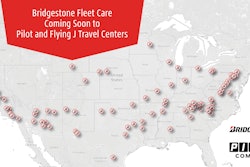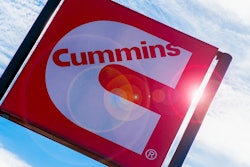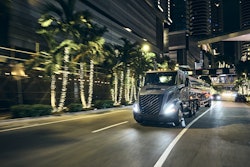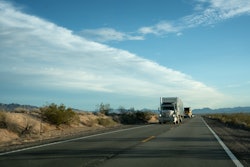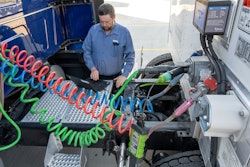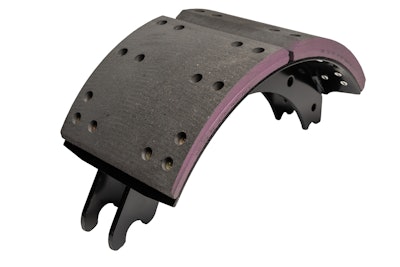
The following was published in CCJ's Air Brake Book, 11th edition, sponsored by SilverbackHD. CCJ's Air Brake Book is a complementary industry resource, courtesy of our partnership with SilverbackHD, the Technology and Maintenance Council and Commercial Vehicle Safety Alliance. You can download the entire Air Brake Book here.
In trucking applications, friction is the force that slows the vehicle. The brake system is the means by which that force is applied, but the brake lining is actually the component that bears the brunt of all the heat, weight, energy and force created during braking.
Brake manufacturers conduct extensive laboratory testing to establish performance baselines for new linings. “Then we do field testing in addition to that to make sure they perform as intended, and that field testing can be several years,” said Scott Corbett, director of technical service and warranty for Haldex. “Some of the linings have as many as 11 different tests to pass, evaluating factors such as fade, wear characteristics, overall component and material performance and high- temperature performance.”
“… the golden rule of truck parts is that you get what you pay for … In everything there is cheap garbage, there is middle of the road reliable and there is high performance.” – Keith Roth, SilverbackHD Vice President of Operations
Additionally, Corbett said, tests are conducted on peripheral characteristics such as lining squeal and vibration. In all, he noted, it is not unusual for linings to undergo more than five years of extensive testing before being released into the marketplace. “Whether you’re working on a motorcycle or you’re working on a severe- duty off-highway vehicle, the concepts are basically the same,” said John Hawker, a retired consulting engineer that previously worked with Bendix and Dana. “You’re transferring energy and motion – kinetic energy – and converting it to heat. That’s what the friction material in a brake pad or shoe does.”
To understand exactly how a brake lining accomplishes this, think of the process of applying a brake pedal as a controlled burn. “Just like you burn fuel to make the vehicle go, you wear friction material to make the vehicle slow down,” explained Hawker.
Because brake linings are designed to wear as they do their job, it makes sense for manufacturers to design linings to last as long as possible to keep maintenance costs down and assure solid braking performance even in abrasive or severe operating conditions.
Each manufacturer guards the compound list for its proprietary brake lining materials with the same sort of zeal that Coca-Cola and KFC guard the ingredients in their products. “Brake linings are made out of many different materials,” Corbett noted. “You’ll find carbon and fiberglass. And there used to be asbestos until we removed it. But all lining manufacturers have special materials they put in lining, and the higher grade or more expensive the lining is, the more premium materials go into that lining.” Most brake linings consist of different amounts of materials blended together in such a way to maximize heat rejection and component life. These include but are not limited to: • Fiber materials, usually comprised of steel, carbon, fiberglass, synthetic or ceramics. • Abrasives such as aluminum oxide, magnesium oxide, zinc oxide and silicon carbide. • Friction modifiers. • Fillers, including inorganic, metallic and organic materials. • Binders, usually phenolic resins and rubber compounds. • Carbonaceous compounds such as coke, carbon and graphite. Each manufacturer blends these compounds in various amounts under computer control. The mix is pressure-cured in long slabs, then baked, cut and shaped. Rivet holes are drilled, and the lining is affixed to a shoe or pad. Samples are pulled and checked to ensure quality and durability, including analysis of moisture content, acidity, fiber size and ash content, among other tests.
Gauging lining life
Choosing the proper replacement and knowing when to replace brake linings is critical for performance, so manufacturers and industry organizations such as the Technology and Maintenance Council and the Society of Automotive Engineers go to great lengths to simplify the selection process when selecting replacement linings.
Common tools are friction thickness or lining thickness gauges built into a shoe or pad to enable technicians to determine at a glance how much useful life is left in the component. Many brake wear gauges have a minimum thickness check, but also have a 50% checkpoint on them. So, they not only will tell you when they need to be replaced, they also can allow you to project the remaining life left on the shoe or pad and schedule the brake maintenance for that vehicle in advance. Another point worth noting is that the majority of brake shoes are sold in kits, which typically consists of two shoes with all the applicable wheel-attaching hardware in the box so technicians will replace all of the wear components that are associated to that wheel end – such as anchor pins, springs, retaining springs and bushings – as well as check radial play in the camshaft and others items that are associated with that brake.
All quality brake shoes and pads will be marked with edge codes on the side of the friction material. These codes give crucial data about the part and help technicians ensure they are replacing it with one that offers comparable performance. Most edge codes start out, typically, by identifying the brand of the material in the pad. Naturally, the manufacturer will be noted as well. If the friction material is designed for extended service, for example, other information such as FMSI identification will follow along with mounting information that tells you if the shoe requires single or dual anchor pins. It also will have a coefficient of friction generated by the material – an alphabetical sequence designating the coefficient of friction for the lining material. Coefficient of friction can be identified as EE, FF or GG, for example. The higher the alphabet scale, the more aggressive the material.
A final piece of data on the edge code tells the batch – or specific manufacturing data – pertinent to the component. This is so that if there is a failure or performance issue with the material, it can be traced back to its manufacturing date, and even down to the exact time of the manufacturing process.
According to Hawker, the most important thing about the edge code of any friction material is the manufacturer’s name. “You need to know who manufactured that part so you know it’s being backed by somebody,” he stressed. “There are many ‘will fit,’ ‘could fit,’ ‘might fit,’ copycat and even counterfeit parts out there on the market today. One part may very well look like the one you’ve just pulled off a truck. But if there’s no name on it, I sure wouldn’t put it on a vehicle, because I wouldn’t want the liability and responsibility that I installed something that’s suspect.”
A fine line
The alphabetical codes found on the side of a brake pad or shoe also can help you select the appropriate lining material mix for the application at hand, said Corbett. “If you have a severe-duty cycle application, like cement mixers, you’re going to need a different material grade than you would for a linehaul-type application,” he noted. “But don’t just depend on edge codes alone.”
All manufacturers provide weight charts that detail how a particular lining corresponds to the weight a vehicle hauls. It’s an easy way to make sure that you’ve done your homework and you’ve chosen the appropriate lining on for the job.
But simply increasing the level of friction material aggressiveness to meet more severe duty cycles is not always the best course of action when optimizing brake linings. “It is a balancing act,” Hawker stressed. “You have to take other factors beyond the friction material into account as well.”
Those factors include air valves, drums, slack adjusters and chamber size. Naturally, a different working environment or driving condition may necessitate changes to a vehicle’s brakes. But simply putting an aggressive brake lining on and assuming that will fix everything is a mistake.
One final piece of the puzzle is the driver. As Corbett noted, nothing affects lining wear like bad habits behind the wheel.
“Excessive braking, running up on stoplights and hitting the brakes at the last minute – all of that takes a toll,” he said.
Heat is another critical factor. “Drum-type brakes are effective up to a certain temperature, and then they start to fade away,” said Corbett. “If a driver keeps his brakes cool and doesn’t abuse them, he’s always got that maximum amount of stopping power if he gets into an emergency. If a driver rides the brakes or overheats them and gets into an emergency situation, he may not have enough stopping power to do what he needs, so it’s important to coach drivers and get them to help you get the most out of the brake linings on that vehicle.”
OEM or aftermarket?
OEM quality or equivalent parts are recommended to ensure that fleets install the same (or better) high-quality components that were designed for the vehicle, but SilverbackHD Vice President of Operations Keith Roth said OEMs can be in a tough spot in that most components are designed to meet certain minimum performance characteristics specified by the engineering department of a component and vehicle manufacturer.
“These specifications are often a balance between meeting certain government required regulations, along with considerations for price and life cycle,” he said. “In the aftermarket, you have the OEM original component as the benchmark, with various performance and cost alternatives competing with this benchmark.”
On one side are the lower cost options. Relined shoes, for example, will perform ok but not as well the as new steel shoes with the same friction, because relined shoes usually have some roughness to the table due to previous corrosion. That, in turn, provides uneven reduced heat dissipation versus a new shoe that will provide a longer life span, according to Roth.
On the other hand, a better performing product is often available in the aftermarket versus the original OEM product – for example, an advanced friction formula that may provide longer life versus the original OEM design, but the OEM chose not to use it because of an increased cost in the production of the vehicle.
“An example of this would be the piston-style spring brake that was subject to high corrosion rates on the exposed piston, which all North American truck OEMs used for vehicle production up until the mid-1970s when fleets demanded that truck OEMs start using the superior double diaphragm design (3030) sold only by the aftermarket,” Roth said. “That is now still the standard today.”
Roth said the golden rule of truck parts is “that you get what you pay for, so be careful who you choose as a partner parts supplier. In everything there is cheap garbage, there is middle of the road reliable and there is high-performance,” he added. “Fleets need to make sure they are buying replacement components from reliable part supplier partners that are committed to lowering their cost per mile.”



